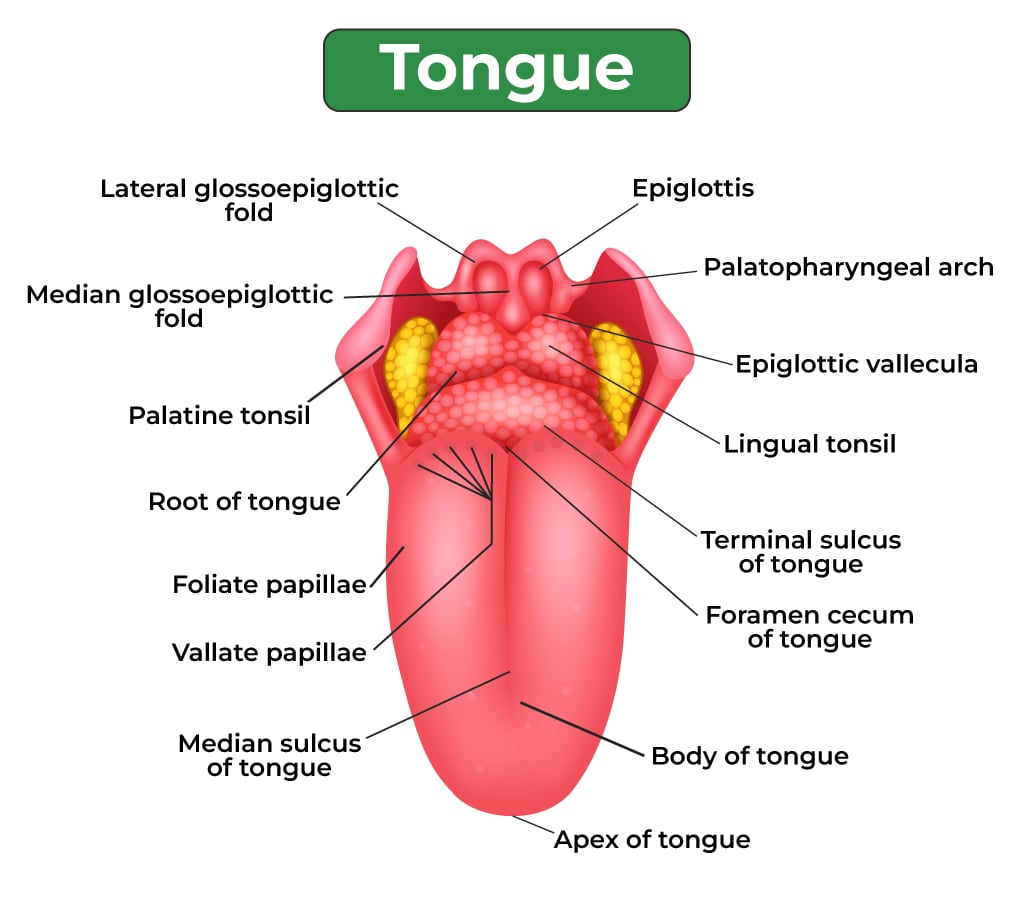Human Tongue - Structure and Diagram: Functions & Diagram
The Human Tongue
The human tongue does important functions, which include speech, taste, and swallowing, which is mostly carried out in coordination. It forms words by articulating sounds, identifies taste, and participates in swallowing movements to transfer food.
Knowing the anatomical structure and the functions of the tongue can perhaps make a person appreciate its importance in everyday activities and in maintaining health.
The tongue is anatomically a muscular organ located in the oral cavity. Different parts of it enable it to perform its varied functions.
The article below is in line with providing information regarding the anatomy in detail, functions, blood supply, and innervation of nerves to the tongue, coupled with some tips for keeping the tongue healthy.
Anatomy Of The Tongue
The anatomy of the tongue can be possibly approached to include its external and internal structures, which in play gives the tongue a unifying function.
The external structure deals with the visible parts of the tongue: the tip, the body, and the base. This plays an important part not only in enabling the organ to move but also in interacting with the oral cavity.
The internal structure is made up of various muscles and papillae that aid in executing its numerous functions: taste, speech, and swallowing. Knowledge of such structures aids in the appreciation of the manner the tongue functions to execute many tasks.
External Structure:
Apex: The anterior, free-moving part of the tongue.
Body: The main, middle part of the tongue.
Root: The posterior part attached to the floor of the mouth.
Don't Miss: Most scoring concepts for NEET | NEET papers with solutions
NEET 2025: Syllabus | PYQs | Crack NEET in 2 months - Study Plan
NEET Important PYQ & Solutions: Physics | Chemistry | Biology | NEET PYQ's (2015-24)
- The Human Tongue
- Anatomy Of The Tongue
- Functions Of The Tongue
- Blood Supply And Nerve Innervation
- Common Disorders Of The Tongue
- Maintaining Tongue Health
- The Video Recommended On Human Tongue:
Internal Structure:
Intrinsic Muscles: Contribute to the shape of the tongue and are responsible for its precise movements.
Extrinsic Muscles: These attach the tongue to other structures and permit broader movements such as protrusion and retraction.
Diagram Of Tongue

Functions Of The Tongue
The tongue performs several functions that are crucial to various physiological processes.
Taste Buds and Taste Zones:
Sensory organs are small, lingual papillae, each of which allows the perception of the five taste sensations: sweet, salty, sour, bitter, and umami.
Taste Perception Mechanism: The receptor cells in the taste buds send signals to the brain and recognise different tastes.
Speech:
As the tongue is busy moving and going to its proper locations, it is what makes pronunciation and articulation of speech very vital.
Swallowing:
The tongue functions in manipulating food by moving it towards the back of the mouth and the pharynx, for proper digestion before swallowing.
Other Functions:
The tongue finds out the temperature and texture, hence creating a puzzling sensory vision of eating.
The tongue cleans the mouth by mixing the food with saliva and aids digestion. Several blood vessels and nerves found in the tongue support its functioning and health.
Blood Supply And Nerve Innervation
The blood supply and nerve innervation support the functioning of the tongue and its health.
Blood Supply:
The lingual artery and the sublingual artery supply blood to the tongue.
Blood from the tongue drains through the lingual veins.
Sensory Nerves:
Include nerves of taste and common sensation.
Motor Nerves:
Include motor nerves supplying the intrinsic and extrinsic muscles of the tongue; these nerves play a vital role in the various actions of the tongue.
Common Disorders Of The Tongue
Ankyloglossia: Restricted tongue mobility due to a short lingual frenulum.
Macroglossia: Enlargement of the tongue.
Glossitis: Inflammation of the tongue.
Oral Thrush: White patches on the tongue due to fungal infection.
Maintaining Tongue Health
The health of the tongue is essential for total oral health and function.
Cleaning Regularly: The tongue is brushed to remove debris and bacteria.
Balanced Diet: It helps in providing adequate nourishment for the upkeep and maintenance of the tongue.
Dental Visits: Regular checkups ensure that conditions get detected and are treated well in time before developing into full-blown problems.
Conclusion
One needs to understand the structure and functions of the tongue to appreciate these very vital roles of the organ in taste, speech, and general health. Ensuring the health of the tongue through good hygiene, proper diet, and regular checkups is very important.
This means it is in charge of eating well, bringing out your speech clearly, and the general health, which gives more reason to develop awareness and care.
The Video Recommended On Human Tongue:
Frequently Asked Questions (FAQs)
The tongue is used as an organ of taste, speech, and deglutition.
The tongue is composed of muscles, papillae over the surface, and taste buds; it is divided into specific zones for various tastes.
The common disorders identified include taste disorders, structural abnormalities, infections like glossitis, and oral thrush.
Maintaining tongue health includes good oral hygiene, a well-balanced diet, and proper dental check-ups.
The functioning of the tongue is controlled by both sensory and motor nerves, primarily those including the lingual nerve and the hypoglossal nerve.
Also Read
30 Nov'24 03:25 PM
26 Nov'24 05:38 PM
25 Nov'24 06:43 PM
25 Nov'24 05:45 PM
25 Nov'24 04:48 PM
25 Nov'24 03:52 PM
23 Nov'24 04:30 PM
23 Nov'24 10:03 AM